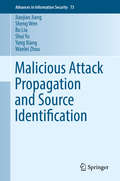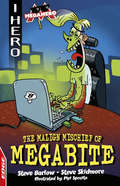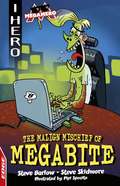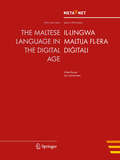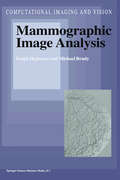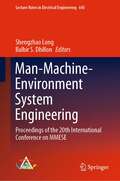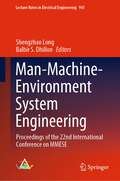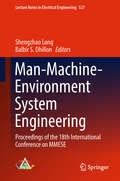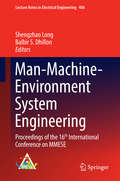- Table View
- List View
Malicious Attack Propagation and Source Identification (Advances in Information Security #73)
by Jiaojiao Jiang Sheng Wen Bo Liu Shui Yu Yang Xiang Wanlei ZhouThis book covers and makes four major contributions: 1) analyzing and surveying the pros and cons of current approaches for identifying rumor sources on complex networks; 2) proposing a novel approach to identify rumor sources in time-varying networks; 3) developing a fast approach to identify multiple rumor sources; 4) proposing a community-based method to overcome the scalability issue in this research area. These contributions enable rumor source identification to be applied effectively in real-world networks, and eventually diminish rumor damages, which the authors rigorously illustrate in this book. In the modern world, the ubiquity of networks has made us vulnerable to various risks. For instance, viruses propagate throughout the Internet and infect millions of computers. Misinformation spreads incredibly fast in online social networks, such as Facebook and Twitter. Infectious diseases, such as SARS, H1N1 or Ebola, have spread geographically and killed hundreds of thousands people. In essence, all of these situations can be modeled as a rumor spreading through a network, where the goal is to find the source of the rumor so as to control and prevent network risks. So far, extensive work has been done to develop new approaches to effectively identify rumor sources. However, current approaches still suffer from critical weaknesses. The most serious one is the complex spatiotemporal diffusion process of rumors in time-varying networks, which is the bottleneck of current approaches. The second problem lies in the expensively computational complexity of identifying multiple rumor sources. The third important issue is the huge scale of the underlying networks, which makes it difficult to develop efficient strategies to quickly and accurately identify rumor sources. These weaknesses prevent rumor source identification from being applied in a broader range of real-world applications. This book aims to analyze and address these issues to make rumor source identification more effective and applicable in the real world. The authors propose a novel reverse dissemination strategy to narrow down the scale of suspicious sources, which dramatically promotes the efficiency of their method. The authors then develop a Maximum-likelihood estimator, which can pin point the true source from the suspects with high accuracy. For the scalability issue in rumor source identification, the authors explore sensor techniques and develop a community structure based method. Then the authors take the advantage of the linear correlation between rumor spreading time and infection distance, and develop a fast method to locate the rumor diffusion source. Theoretical analysis proves the efficiency of the proposed method, and the experiment results verify the significant advantages of the proposed method in large-scale networks. This book targets graduate and post-graduate students studying computer science and networking. Researchers and professionals working in network security, propagation models and other related topics, will also be interested in this book.
Malicious Bots: An Inside Look into the Cyber-Criminal Underground of the Internet
by Ken Dunham Jim MelnickOriginally designed as neutral entities, computerized bots are increasingly being used maliciously by online criminals in mass spamming events, fraud, extortion, identity theft, and software theft. Malicious Bots: An Inside Look into the Cyber-Criminal Underground of the Internet explores the rise of dangerous bots and exposes the nefarious methods of "botmasters". This valuable resource assists information security managers in understanding the scope, sophistication, and criminal uses of bots. With sufficient technical detail to empower IT professionals, this volume provides in-depth coverage of the top bot attacks against financial and government networks over the last several years. The book presents exclusive details of the operation of the notorious Thr34t Krew, one of the most malicious bot herder groups in recent history. Largely unidentified by anti-virus companies, their bots spread globally for months, launching massive distributed denial of service (DDoS) attacks and warez (stolen software distributions). For the first time, this story is publicly revealed, showing how the botherders got arrested, along with details on other bots in the world today. Unique descriptions of the criminal marketplace - how criminals make money off of your computer - are also a focus of this exclusive book! With unprecedented detail, the book goes on to explain step-by-step how a hacker launches a botnet attack, providing specifics that only those entrenched in the cyber-crime investigation world could possibly offer. Authors Ken Dunham and Jim Melnick serve on the front line of critical cyber-attacks and countermeasures as experts in the deployment of geopolitical and technical bots. Their work involves advising upper-level government officials and executives who control some of the largest networks in the world. By examining the methods of Internet predators, information security managers will be better able to proactively protect their own networks from such attacks.
Malicious Cryptography: Exposing Cryptovirology
by Adam Young Moti YungHackers have uncovered the dark side of cryptography—that device developed to defeat Trojan horses, viruses, password theft, and other cyber-crime. It’s called cryptovirology, the art of turning the very methods designed to protect your data into a means of subverting it. In this fascinating, disturbing volume, the experts who first identified cryptovirology show you exactly what you’re up against and how to fight back. They will take you inside the brilliant and devious mind of a hacker—as much an addict as the vacant-eyed denizen of the crackhouse—so you can feel the rush and recognize your opponent’s power. Then, they will arm you for the counterattack. This book reads like a futuristic fantasy, but be assured, the threat is ominously real. Vigilance is essential, now. Understand the mechanics of computationally secure information stealing Learn how non-zero sum Game Theory is used to develop survivable malware Discover how hackers use public key cryptography to mount extortion attacks Recognize and combat the danger of kleptographic attacks on smart-card devices Build a strong arsenal against a cryptovirology attack
The Malign Mischief of MegaBite (EDGE: I HERO: Megahero #5)
by Steve Barlow Steve SkidmoreTake on the role of a shape-shifting MEGAHERO in this fully interactive, wacky, choose-your-own-destiny adventure story.You and your mega-computer sidekick, PAL, must save the world from MegaBite - an ultra-skilled and not-very-nice computer hacker. The evil genius has built a web of scams online - can you possibly morph into the right shapes to unravel his coordinated cyber attacks?? Written by the award-winning duo Steve Barlow and Steve Skidmore (AKA the 2STEVES) and illustrated by the hilarious Pipi Sposito. Reading age from 7 to 9 years old. Interest range from 7 to 12 years old - suitable for reluctant readers and less confident older readers. Printed using a font approved by the British Dyslexia Association on off-white paper.Read and laugh along with the whole series!October 2020I HERO: MegaHero: Sushi Man - 9781445169477I HERO: MegaHero: Professor Weird - 9781445170039November 2020I HERO: MegaHero: DinaSaw - 9781445170084I HERO: MegaHero: Miss Take - 9781445170091December 2020I HERO: MegaHero: MegaBite - 9781445170121I HERO: MegaHero: Queen of Hearts - 9781445170152
The Malign Mischief of MegaBite (EDGE: I HERO: Megahero)
by Steve Barlow Steve SkidmoreTake on the role of a shape-shifting MEGAHERO in this fully interactive, wacky, choose-your-own-destiny adventure story.You and your mega-computer sidekick, PAL, must save the world from MegaBite - an ultra-skilled and not-very-nice computer hacker. The evil genius has built a web of scams online - can you possibly morph into the right shapes to unravel his coordinated cyber attacks?? Written by the award-winning duo Steve Barlow and Steve Skidmore (AKA the 2STEVES) and illustrated by the hilarious Pipi Sposito. Reading age from 7 to 9 years old. Interest range from 7 to 12 years old - suitable for reluctant readers and less confident older readers. Printed using a font approved by the British Dyslexia Association on off-white paper.Read and laugh along with the whole series!October 2020I HERO: MegaHero: Sushi Man - 9781445169477I HERO: MegaHero: Professor Weird - 9781445170039November 2020I HERO: MegaHero: DinaSaw - 9781445170084I HERO: MegaHero: Miss Take - 9781445170091December 2020I HERO: MegaHero: MegaBite - 9781445170121I HERO: MegaHero: Queen of Hearts - 9781445170152
The Maltese Language in the Digital Age (White Paper Series)
by Georg Rehm Hans UszkoreitThis white paper is part of a series that promotes knowledge about language technology and its potential. It addresses educators, journalists, politicians, language communities and others. The availability and use of language technology in Europe varies between languages. Consequently, the actions that are required to further support research and development of language technologies also differ for each language. The required actions depend on many factors, such as the complexity of a given language and the size of its community. META-NET, a Network of Excellence funded by the European Commission, has conducted an analysis of current language resources and technologies. This analysis focused on the 23 official European languages as well as other important national and regional languages in Europe. The results of this analysis suggest that there are many significant research gaps for each language. A more detailed expert analysis and assessment of the current situation will help maximise the impact of additional research and minimize any risks. META-NET consists of 54 research centers from 33 countries that are working with stakeholders from commercial businesses, government agencies, industry, research organisations, software companies, technology providers and European universities. Together, they are creating a common technology vision while developing a strategic research agenda that shows how language technology applications can address any research gaps by 2020.
Malware Analysis and Detection Engineering: A Comprehensive Approach to Detect and Analyze Modern Malware
by Abhijit Mohanta Anoop SaldanhaDiscover how the internals of malware work and how you can analyze and detect it. You will learn not only how to analyze and reverse malware, but also how to classify and categorize it, giving you insight into the intent of the malware. Malware Analysis and Detection Engineering is a one-stop guide to malware analysis that simplifies the topic by teaching you undocumented tricks used by analysts in the industry. You will be able to extend your expertise to analyze and reverse the challenges that malicious software throws at you. The book starts with an introduction to malware analysis and reverse engineering to provide insight on the different types of malware and also the terminology used in the anti-malware industry. You will know how to set up an isolated lab environment to safely execute and analyze malware. You will learn about malware packing, code injection, and process hollowing plus how to analyze, reverse, classify, and categorize malware using static and dynamic tools. You will be able to automate your malware analysis process by exploring detection tools to modify and trace malware programs, including sandboxes, IDS/IPS, anti-virus, and Windows binary instrumentation.The book provides comprehensive content in combination with hands-on exercises to help you dig into the details of malware dissection, giving you the confidence to tackle malware that enters your environment.What You Will LearnAnalyze, dissect, reverse engineer, and classify malwareEffectively handle malware with custom packers and compilersUnpack complex malware to locate vital malware components and decipher their intentUse various static and dynamic malware analysis tools Leverage the internals of various detection engineering tools to improve your workflow Write Snort rules and learn to use them with Suricata IDS Who This Book Is ForSecurity professionals, malware analysts, SOC analysts, incident responders, detection engineers, reverse engineers, and network security engineers"This book is a beast! If you're looking to master the ever-widening field of malware analysis, look no further. This is the definitive guide for you." Pedram Amini, CTO Inquest; Founder OpenRCE.org and ZeroDayInitiative
Malware Analysis Using Artificial Intelligence and Deep Learning
by Mark Stamp Mamoun Alazab Andrii ShalaginovThis book is focused on the use of deep learning (DL) and artificial intelligence (AI) as tools to advance the fields of malware detection and analysis. The individual chapters of the book deal with a wide variety of state-of-the-art AI and DL techniques, which are applied to a number of challenging malware-related problems. DL and AI based approaches to malware detection and analysis are largely data driven and hence minimal expert domain knowledge of malware is needed.This book fills a gap between the emerging fields of DL/AI and malware analysis. It covers a broad range of modern and practical DL and AI techniques, including frameworks and development tools enabling the audience to innovate with cutting-edge research advancements in a multitude of malware (and closely related) use cases.
Malware Analyst's Cookbook and DVD: Tools and Techniques for Fighting Malicious Code
by Michael Ligh Steven Adair Blake Hartstein Matthew RichardA computer forensics "how-to" for fighting malicious code and analyzing incidents With our ever-increasing reliance on computers comes an ever-growing risk of malware. Security professionals will find plenty of solutions in this book to the problems posed by viruses, Trojan horses, worms, spyware, rootkits, adware, and other invasive software. Written by well-known malware experts, this guide reveals solutions to numerous problems and includes a DVD of custom programs and tools that illustrate the concepts, enhancing your skills. Security professionals face a constant battle against malicious software; this practical manual will improve your analytical capabilities and provide dozens of valuable and innovative solutions Covers classifying malware, packing and unpacking, dynamic malware analysis, decoding and decrypting, rootkit detection, memory forensics, open source malware research, and much more Includes generous amounts of source code in C, Python, and Perl to extend your favorite tools or build new ones, and custom programs on the DVD to demonstrate the solutions Malware Analyst's Cookbook is indispensible to IT security administrators, incident responders, forensic analysts, and malware researchers.
Malware Analyst's Cookbook and DVD: Tools and Techniques for Fighting Malicious Code
by Michael Ligh Steven Adair Blake Hartstein Matthew RichardA computer forensics "how-to" for fighting malicious code and analyzing incidents With our ever-increasing reliance on computers comes an ever-growing risk of malware. Security professionals will find plenty of solutions in this book to the problems posed by viruses, Trojan horses, worms, spyware, rootkits, adware, and other invasive software. Written by well-known malware experts, this guide reveals solutions to numerous problems and includes a DVD of custom programs and tools that illustrate the concepts, enhancing your skills. Security professionals face a constant battle against malicious software; this practical manual will improve your analytical capabilities and provide dozens of valuable and innovative solutions Covers classifying malware, packing and unpacking, dynamic malware analysis, decoding and decrypting, rootkit detection, memory forensics, open source malware research, and much more Includes generous amounts of source code in C, Python, and Perl to extend your favorite tools or build new ones, and custom programs on the DVD to demonstrate the solutions Malware Analyst's Cookbook is indispensible to IT security administrators, incident responders, forensic analysts, and malware researchers.
Malware Detection (Advances in Information Security #27)
by Somesh Jha Cliff Wang Dawn Song Douglas Maughan Mihai ChristodorescuThis book captures the state of the art research in the area of malicious code detection, prevention and mitigation. It contains cutting-edge behavior-based techniques to analyze and detect obfuscated malware. The book analyzes current trends in malware activity online, including botnets and malicious code for profit, and it proposes effective models for detection and prevention of attacks using. Furthermore, the book introduces novel techniques for creating services that protect their own integrity and safety, plus the data they manage.
Malware Diffusion Models for Modern Complex Networks: Theory and Applications
by Vasileios Karyotis M.H.R. KhouzaniMalware Diffusion Models for Wireless Complex Networks: Theory and Applications provides a timely update on malicious software (malware), a serious concern for all types of network users, from laymen to experienced administrators. As the proliferation of portable devices, namely smartphones and tablets, and their increased capabilities, has propelled the intensity of malware spreading and increased its consequences in social life and the global economy, this book provides the theoretical aspect of malware dissemination, also presenting modeling approaches that describe the behavior and dynamics of malware diffusion in various types of wireless complex networks. Sections include a systematic introduction to malware diffusion processes in computer and communications networks, an analysis of the latest state-of-the-art malware diffusion modeling frameworks, such as queuing-based techniques, calculus of variations based techniques, and game theory based techniques, also demonstrating how the methodologies can be used for modeling in more general applications and practical scenarios.Presents a timely update on malicious software (malware), a serious concern for all types of network users, from laymen to experienced administratorsSystematically introduces malware diffusion processes, providing the relevant mathematical backgroundDiscusses malware modeling frameworks and how to apply them to complex wireless networksProvides guidelines and directions for extending the corresponding theories in other application domains, demonstrating such possibility by using application models in information dissemination scenarios
Malware Forensics: Investigating and Analyzing Malicious Code
by Cameron H. Malin Eoghan Casey James M. AquilinaMalware Forensics: Investigating and Analyzing Malicious Code covers the complete process of responding to a malicious code incident. Written by authors who have investigated and prosecuted federal malware cases, this book deals with the emerging and evolving field of live forensics, where investigators examine a computer system to collect and preserve critical live data that may be lost if the system is shut down. Unlike other forensic texts that discuss live forensics on a particular operating system, or in a generic context, this book emphasizes a live forensics and evidence collection methodology on both Windows and Linux operating systems in the context of identifying and capturing malicious code and evidence of its effect on the compromised system. It is the first book detailing how to perform live forensic techniques on malicious code. The book gives deep coverage on the tools and techniques of conducting runtime behavioral malware analysis (such as file, registry, network and port monitoring) and static code analysis (such as file identification and profiling, strings discovery, armoring/packing detection, disassembling, debugging), and more. It explores over 150 different tools for malware incident response and analysis, including forensic tools for preserving and analyzing computer memory. Readers from all educational and technical backgrounds will benefit from the clear and concise explanations of the applicable legal case law and statutes covered in every chapter. In addition to the technical topics discussed, this book also offers critical legal considerations addressing the legal ramifications and requirements governing the subject matter. This book is intended for system administrators, information security professionals, network personnel, forensic examiners, attorneys, and law enforcement working with the inner-workings of computer memory and malicious code.* Winner of Best Book Bejtlich read in 2008!* http://taosecurity.blogspot.com/2008/12/best-book-bejtlich-read-in-2008.html* Authors have investigated and prosecuted federal malware cases, which allows them to provide unparalleled insight to the reader.* First book to detail how to perform "live forensic" techniques on malicous code.* In addition to the technical topics discussed, this book also offers critical legal considerations addressing the legal ramifications and requirements governing the subject matter
Malware Forensics Field Guide for Linux Systems: Digital Forensics Field Guides
by Cameron H. Malin Eoghan Casey James M. AquilinaMalware Forensics Field Guide for Linux Systems is a handy reference that shows students the essential tools needed to do computer forensics analysis at the crime scene. It is part of Syngress Digital Forensics Field Guides, a series of companions for any digital and computer forensic student, investigator or analyst. Each Guide is a toolkit, with checklists for specific tasks, case studies of difficult situations, and expert analyst tips that will aid in recovering data from digital media that will be used in criminal prosecution. This book collects data from all methods of electronic data storage and transfer devices, including computers, laptops, PDAs and the images, spreadsheets and other types of files stored on these devices. It is specific for Linux-based systems, where new malware is developed every day. The authors are world-renowned leaders in investigating and analyzing malicious code. Chapters cover malware incident response - volatile data collection and examination on a live Linux system; analysis of physical and process memory dumps for malware artifacts; post-mortem forensics - discovering and extracting malware and associated artifacts from Linux systems; legal considerations; file identification and profiling initial analysis of a suspect file on a Linux system; and analysis of a suspect program. This book will appeal to computer forensic investigators, analysts, and specialists.A compendium of on-the-job tasks and checklistsSpecific for Linux-based systems in which new malware is developed every dayAuthors are world-renowned leaders in investigating and analyzing malicious code
Malware Forensics Field Guide for Windows Systems: Digital Forensics Field Guides
by Cameron H. Malin Eoghan Casey James M. AquilinaMalware Forensics Field Guide for Windows Systems is a handy reference that shows students the essential tools needed to do computer forensics analysis at the crime scene. It is part of Syngress Digital Forensics Field Guides, a series of companions for any digital and computer forensic student, investigator or analyst. Each Guide is a toolkit, with checklists for specific tasks, case studies of difficult situations, and expert analyst tips that will aid in recovering data from digital media that will be used in criminal prosecution. This book collects data from all methods of electronic data storage and transfer devices, including computers, laptops, PDAs and the images, spreadsheets and other types of files stored on these devices. It is specific for Windows-based systems, the largest running OS in the world. The authors are world-renowned leaders in investigating and analyzing malicious code. Chapters cover malware incident response - volatile data collection and examination on a live Windows system; analysis of physical and process memory dumps for malware artifacts; post-mortem forensics - discovering and extracting malware and associated artifacts from Windows systems; legal considerations; file identification and profiling initial analysis of a suspect file on a Windows system; and analysis of a suspect program. This field guide is intended for computer forensic investigators, analysts, and specialists.A condensed hand-held guide complete with on-the-job tasks and checklistsSpecific for Windows-based systems, the largest running OS in the worldAuthors are world-renowned leaders in investigating and analyzing malicious code
Malware Forensics (PDF): Investigating And Analyzing Malicious Code
by Cameron H. Malin Eoghan Casey James M. AquilinaMalware Forensics: Investigating and Analyzing Malicious Code covers the complete process of responding to a malicious code incident. Written by authors who have investigated and prosecuted federal malware cases, this book deals with the emerging and evolving field of live forensics, where investigators examine a computer system to collect and preserve critical live data that may be lost if the system is shut down. Unlike other forensic texts that discuss live forensics on a particular operating system, or in a generic context, this book emphasizes a live forensics and evidence collection methodology on both Windows and Linux operating systems in the context of identifying and capturing malicious code and evidence of its effect on the compromised system. It is the first book detailing how to perform live forensic techniques on malicious code.
Malware Science: A comprehensive guide to detection, analysis, and compliance
by Shane MolinariUnlock the secrets of malware data science with cutting-edge techniques, AI-driven analysis, and international compliance standards to stay ahead of the ever-evolving cyber threat landscapeKey FeaturesGet introduced to three primary AI tactics used in malware and detectionLeverage data science tools to combat critical cyber threatsUnderstand regulatory requirements for using AI in cyber threat managementPurchase of the print or Kindle book includes a free PDF eBookBook DescriptionIn today's world full of online threats, the complexity of harmful software presents a significant challenge for detection and analysis. This insightful guide will teach you how to apply the principles of data science to online security, acting as both an educational resource and a practical manual for everyday use. Malware Science starts by explaining the nuances of malware, from its lifecycle to its technological aspects before introducing you to the capabilities of data science in malware detection by leveraging machine learning, statistical analytics, and social network analysis. As you progress through the chapters, you’ll explore the analytical methods of reverse engineering, machine language, dynamic scrutiny, and behavioral assessments of malicious software. You’ll also develop an understanding of the evolving cybersecurity compliance landscape with regulations such as GDPR and CCPA, and gain insights into the global efforts in curbing cyber threats. By the end of this book, you’ll have a firm grasp on the modern malware lifecycle and how you can employ data science within cybersecurity to ward off new and evolving threats.What you will learnUnderstand the science behind malware data and its management lifecycleExplore anomaly detection with signature and heuristics-based methodsAnalyze data to uncover relationships between data points and create a network graphDiscover methods for reverse engineering and analyzing malwareUse ML, advanced analytics, and data mining in malware data analysis and detectionExplore practical insights and the future state of AI’s use for malware data scienceUnderstand how NLP AI employs algorithms to analyze text for malware detectionWho this book is forThis book is for cybersecurity experts keen on adopting data-driven defense methods. Data scientists will learn how to apply their skill set to address critical security issues, and compliance officers navigating global regulations like GDPR and CCPA will gain indispensable insights. Academic researchers exploring the intersection of data science and cybersecurity, IT decision-makers overseeing organizational strategy, and tech enthusiasts eager to understand modern cybersecurity will also find plenty of useful information in this guide. A basic understanding of cybersecurity and information technology is a prerequisite.
Mambo: Installation, Administration, Anwendung und Entwicklung (Xpert.press)
by Robert DeutzDas Buch ist einerseits ein Nachschlagewerk für die Nutzer von Mambo mit einer Darstellung aller Menüs und Konfigurationsmöglichkeiten, andererseits ein umfangreiches Praxiswerk mit der Beschreibung des Aufbaus einer Website mit Mambo, beginnend mit der Installation, über die Umsetzung verschiedener Anforderungen, bis hin zur Einrichtung eines Webshops. Dabei ist das Werk so angelegt, dass für die Realisierung einer Mambo-Website keine Programmierkenntnisse notwendig sind. Für den fortgeschrittenen Leser (bzw. Leser mit PHP-Kenntnissen) gibt es eine Funktionsbeschreibung der internen Mambo-PHP-Funktionen. Mit diesem Buch kann ein Leser eine Website mit Mambo funktionsfähig implementieren.
Mammographic Image Analysis (Computational Imaging and Vision #14)
by R. Highnam J.M. BradyBreast cancer is a major health problem in the Western world, where it is the most common cancer among women. Approximately 1 in 12 women will develop breast cancer during the course of their lives. Over the past twenty years there have been a series of major advances in the manage ment of women with breast cancer, ranging from novel chemotherapy and radiotherapy treatments to conservative surgery. The next twenty years are likely to see computerized image analysis playing an increasingly important role in patient management. As applications of image analysis go, medical applications are tough in general, and breast cancer image analysis is one of the toughest. There are many reasons for this: highly variable and irregular shapes of the objects of interest, changing imaging conditions, and the densely textured nature of the images. Add to this the increasing need for quantitative informa tion, precision, and reliability (very few false positives), and the image pro cessing challenge becomes quite daunting, in fact it pushes image analysis techniques right to their limits.
The Man from the Future: The Visionary Life of John von Neumann
by Ananyo Bhattacharya'A sparkling book, with an intoxicating mix of pen-portraits and grand historical narrative. Above all it fizzes with a dizzying mix of deliciously vital ideas. . . A staggering achievement' Tim HarfordAn exhilarating new biography of John von Neumann: the lost genius who invented our worldThe smartphones in our pockets and computers like brains. The vagaries of game theory and evolutionary biology. Self-replicating moon bases and nuclear weapons. All bear the fingerprints of one remarkable man: John von Neumann.Born in Budapest at the turn of the century, von Neumann is one of the most influential scientists to have ever lived. His colleagues believed he had the fastest brain on the planet - bar none. He was instrumental in the Manhattan Project and helped formulate the bedrock of Cold War geopolitics and modern economic theory. He created the first ever programmable digital computer. He prophesied the potential of nanotechnology and, from his deathbed, expounded on the limits of brains and computers - and how they might be overcome.Taking us on an astonishing journey, Ananyo Bhattacharya explores how a combination of genius and unique historical circumstance allowed a single man to sweep through so many different fields of science, sparking revolutions wherever he went.Insightful and illuminating, The Man from the Future is a thrilling intellectual biography of the visionary thinker who shaped our century.
Man-Machine-Environment System Engineering: Proceedings of the 20th International Conference on MMESE (Lecture Notes in Electrical Engineering #645)
by Balbir S. Dhillon Shengzhao LongThis book presents selected papers introducing readers to the key research topics and latest development trends in the theory and application of MMESE. The advanced integrated research topic man-machine-environment system engineering (MMESE) was first established in China by Professor Shengzhao Long in 1981, with direct support from one of the greatest modern Chinese scientists, Xuesen Qian. In a letter to Shengzhao Long from October 22nd, 1993, Xuesen Qian wrote: “You have created a very important modern science and technology in China!”MMESE primarily focuses on the relationship between man, machine and environment, studying the optimum combination of man-machine-environment systems, where “man” refers to people in the workplace (e.g., operators, decision-makers), “machine” is the general name for any object controlled by man (including tools, machinery, computers, systems and technologies), and “environment” describes the specific working conditions under which man and machine interact (e.g., temperature, noise, vibration and hazardous gases). The three goals of optimizing such systems are ensuring safety, efficiency and economy.Presenting interdisciplinary studies on the concepts and methods in physiology, psychology, system engineering, computer science, environmental science, management, education and other related disciplines, this book is a valuable resource for all researchers and professionals whose work involves MMESE subjects.
Man-Machine-Environment System Engineering: Proceedings of the 22nd International Conference on MMESE (Lecture Notes in Electrical Engineering #941)
by Balbir S. Dhillon Shengzhao LongMan-Machine-Environment System Engineering: Proceedings of the 22nd Conference on MMESE are an academic showcase of the best papers selected from more than 500 submissions, introducing readers to the top research topics and the latest developmental trends in the theory and application of MMESE. This proceedings are interdisciplinary studies on the concepts and methods of physiology, psychology, system engineering, computer science, environment science, management, education, and other related disciplines. Researchers and professionals who study an interdisciplinary subject crossing above disciplines or researchers on MMESE subject will be mainly benefited from this proceedingsMMESE primarily focuses on the relationship between Man, Machine and Environment, studying the optimum combination of man-machine-environment systems. In this system, “Man” refers to working people as the subject in the workplace (e.g. operators, decision-makers); “Machine” is the general name for any object controlled by Man (including tools, machinery, computers, systems and technologies), and “Environment” describes the specific working conditions under which Man and Machine interact (e.g. temperature, noise, vibration, hazardous gases etc.). The three goals of optimization of the man-machine-environment systems are to ensure safety, efficiency and economy. The integrated and advanced science research topic Man-Machine-Environment System Engineering (MMESE) was first established in China by Professor Shengzhao Long in 1981, with direct support from one of the greatest modern Chinese scientists, Xuesen Qian. In a letter to Shengzhao Long from October 22nd, 1993, Xuesen Qian wrote: “You have created a very important modern science and technology in China!”
Man-Machine-Environment System Engineering: Proceedings of the 18th International Conference on MMESE (Lecture Notes in Electrical Engineering #527)
by Shengzhao Long Balbir S. DhillonThese proceedings showcase the best papers selected from more than 500 submissions, and introduce readers to the hottest research topics and the latest developmental trends in the theory and application of MMESE. The integrated and advanced science research topic Man-Machine-Environment System Engineering (MMESE) was first established in China by Professor Shengzhao Long in 1981, with direct support from one of the greatest modern Chinese scientists, Xuesen Qian. In a letter to Long from October 22nd, 1993, Qian wrote: “You have created a very important modern science and technology in China!” MMESE primarily focuses on the relationship between Man, Machine and Environment, studying the optimum combination of man-machine-environment systems. In this system, “Man” refers to working people as the subject in the workplace (e.g. operators, decision-makers); “Machine” is the general name for any object controlled by Man (including tools, machinery, computers, systems and technologies), and “Environment” describes the specific working conditions under which Man and Machine interact (e.g. temperature, noise, vibration, hazardous gases etc.). The three main goals of optimizing man-machine-environment systems are to ensure safety, efficiency and economy. These proceedings present interdisciplinary studies on essential concepts and methods from physiology, psychology, system engineering, computer science, environmental science, management, education, and other related disciplines. As such, they offer a valuable resource for all researchers and professionals whose work involves interdisciplinary areas touching on MMESE subjects.
Man-Machine-Environment System Engineering: Proceedings of the 16th International Conference on MMESE (Lecture Notes in Electrical Engineering #406)
by Shengzhao Long Balbir S. DhillonThis research topic was first established in China by Professor Shengzhao Long in 1981, with direct support from one of the greatest modern Chinese scientists, Xuesen Qian. In a letter to Shengzhao Long from October 22nd, 1993, Xuesen Qian wrote: “You have created a very important modern science subject and technology in China!”MMESE primarily focuses on the relationship between Man, Machine and Environment, studying the optimum combination of man-machine-environment systems. In this system, “Man” refers to working people as the subject in the workplace (e.g. operators, decision-makers); “Machine” is the general name for any object controlled by Man (including tools, machinery, computers, systems and technologies), and “Environment” describes the specific working conditions under which Man and Machine interact (e.g. temperature, noise, vibration, hazardous gases etc.). The three goals of optimization are to ensure "Safety, High efficiency and Economy" of man-machine-environment systems.These proceedings are an academic showcase of the best papers selected from more than 400 submissions, introducing readers to the top research topics and the latest developmental trends in the theory and application of MMESE.These proceedings are interdisciplinary studies on the concepts and methods of physiology, psychology, system engineering, computer science, environment science, management, education, and other related disciplines. Researchers and professionals who study an interdisciplinary subject crossing above disciplines or researchers on MMESE subject will be mainly benefited from these proceedings.
Man-Machine-Environment System Engineering: Commemorative Conference for the 110th Anniversary of Xuesen Qian’s Birth and the 40th Anniversary of Founding of Man-Machine-Environment System Engineering (Lecture Notes in Electrical Engineering #800)
by Shengzhao Long Balbir S. DhillonMan-Machine-Environment System Engineering: Proceedings of the 21st Conference on MMESE is the academic showcase of best research papers selected from more than 500 submissions each year. From this book reader will learn the best research topics and the latest development trend in MMESE design theory and other human-centered system application.MMESE focus mainly on the relationship between Man, Machine and Environment. It studies the optimum combination of man-machine-environment systems. In the system, the Man means the working people as the subject in the workplace (e.g. operator, decision-maker); the Machine means the general name of any object controlled by the Man (including tool, Machinery, Computer, system and technology), the Environment means the specially working conditions under which Man and Machine occupy together(e.g. temperature, noise, vibration, hazardous gases etc.). The three goals of the optimization of the system are safety, efficiency and economy.In 1981 with direct support from one of the greatest modern Chinese scientists, Qian Xuesen, Man-Machine-Environment System Engineering (MMESE), the integrated and advanced science research topic was established in China by Professor Shengzhao Long. In the letter to Shengzhao Long, in October 22nd, 1993, Qian Xuesen wrote: “You have created a very important modern science subject and technology in China!”.
